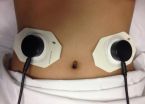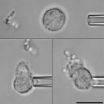(Press-News.org) ROCHESTER, Minn. — A recent study conducted by Mayo Clinic researchers recommends laparoscopic cholecystectomies (surgical removal of the gallbladder) for pediatric patients suffering from gallstones and other gallbladder diseases. This study was published in Surgical Laparoscopy Endoscopy & Percutaneous Techniques.
MULTIMEDIA ALERT: Video and audio are available for download on the Mayo Clinic News Network.
A cholecystectomy is a surgical procedure performed to remove the gallbladder, a pear-shaped organ located below the liver on the upper right side of the abdomen. The gallbladder is responsible for collecting and storing bile, which is a fluid secreted by the liver. During a laparoscopic cholecystectomy, four incisions are made in the abdomen. Then, a small video camera and other special tools are used to remove the gallbladder.
"Cholelithiasis and other gallbladder diseases requiring cholecystectomies are less common in children compared to adults," says Michael B. Ishitani, M.D., lead author of the study. "Recently, however, rising rates of obesity in the pediatric population have led to an increase of gallstones found in children. Therefore, it was important for us to review the current clinical practices to ensure that pediatric patients are being treated properly."
The study analyzed 202 cases of laparoscopic cholecystectomy performed on children below 18 years of age between the years 1990 and 2010. Researchers found that no common bile duct injuries were reported in the study group. In the follow–up, only 9 percent of patients still had some abdominal pain without associated gallbladder disease or gallstones. Therefore, the study concluded that laparoscopic cholecystectomies are safe procedures to perform on pediatric patients.
"We are refining our surgical techniques and are now performing all pediatric laparoscopic cholecystectomies using a small incision through the belly button. However, further studies are required to elucidate which pediatric patients will benefit the most from gallbladder removal," explains Dr. Ishitani.
INFORMATION:
About Mayo Clinic
Mayo Clinic is a nonprofit organization committed to medical research and education, and providing expert, whole-person care to everyone who needs healing. For more information, visit http://www.mayoclinic.org/about-mayo-clinic or http://newsnetwork.mayoclinic.org/.
Laparoscopic surgical removal of the gallbladder in pediatric patients is safe
2014-08-07
ELSE PRESS RELEASES FROM THIS DATE:
New disposable biosensor may help physicians determine which patients can safely be fed following surgery
2014-08-07
A disposal, plastic listening device that attaches to the abdomen may help doctors definitively determine which post-operative patients should be fed and which should not, an invention that may improve outcomes, decrease healthcare costs and shorten hospital stays, according to a UCLA study.
Some patients who undergo surgery develop a condition called post-operative ileus (POI), a malfunction of the intestines. The condition causes patients to become ill if they eat too soon, which can lengthen an affected patient's hospital stay by two to three days. Until now, there ...
Team determines structure of a molecular machine that targets viral DNA for destruction
2014-08-07
BOZEMAN, Mont. – With a featured publication in the Aug. 7 issue of Science, Montana State University researchers have made a significant contribution to the understanding of a new field of DNA research, with the acronym CRISPR, that holds enormous promise for fighting infectious diseases and genetic disorders.
The MSU-led research provides the first detailed blueprint of a multi-subunit "molecular machinery" that bacteria use to detect and destroy invading viruses.
"We generally think of bacteria as making us sick, but rarely do we consider what happens when the ...
Expert insights on in vitro alternatives for drug and chemical toxicity testing
2014-08-07
New Rochelle, NY, August 7, 2014—In vitro toxicity testing is rapidly being adopted in the pharmaceutical, chemical, and cosmetics industries, for example, as an alternative to animal studies to predict adverse health effects of drugs and personal care products and the health consequences of environmental exposures. An insightful Roundtable Discussion focused on how to apply these novel toxicology models to everyday hazard prediction, risk assessment, and decision making in industry is published in the preview issue of the new journal Applied In Vitro Toxicology, a peer-reviewed ...
The typhoid fever pathogen uses a cloaking mechanism to evade neutrophil neutralization
2014-08-07
Typhoid fever is caused by systemic (body-wide) infection with Salmonella enterica Typhi. In contrast, infection with the closely related bacterium Salmonella enterica Thyphimurium is usually limited to the gut and causes less serious diarrheal disease. Research published on August 7th in PLOS Pathogens comparing the two pathogens reveals how S. Typhi avoids recognition and elimination by patrolling immune cells called neutrophils, allowing it to disseminate throughout the patient's body.
Neutrophils track down microbial invaders and gobble them up. To investigate why ...
Stanford researchers use fruit flies to unlock mysteries of human diabetes
2014-08-07
For the first time, the tiny fruit fly can be used to study how mutations associated with the development of diabetes affect the production and secretion of the vital hormone insulin.
The advance is due to a new technique devised by researchers at the Stanford University School of Medicine that allows scientists to measure insulin levels in the insects with extremely high sensitivity and reproducibility.
The experimental model is likely to transform the field of diabetes research by bringing the staggering power of fruit fly genetics, honed over 100 years of research, ...
Small, origami-inspired pop-up robots function autonomously
2014-08-07
This release is available in Japanese.
Inspired by the traditional Japanese art form of Origami or "folding paper," researchers have developed a way to coax flat sheets of composite materials to self-fold into complex robots that crawl and turn.
"We demonstrated this process by building a robot that folds itself and walks away without human assistance," said Sam Felton, a Ph.D. candidate at Harvard University's School of Engineering and Applied Sciences and the Wyss Institute for Biologically Inspired Engineering and the lead author of a new report in the 8 August ...
Ocean's most oxygen-deprived zones to shrink under climate change
2014-08-07
As the complex story of climate change unfolds, many of the endings are grim. But there are exceptions. Predictions that the lowest-oxygen environments in the ocean would get worse may not come to pass. Instead, University of Washington research shows climate change, as it weakens the trade winds, could shrink the size of these extreme low-oxygen waters.
"The tropics should actually get better oxygenated as the climate warms up," said Curtis Deutsch, a UW associate professor of oceanography. He is lead author of the study published Aug. 8 in Science.
Warmer water contains ...
Water 'microhabitats' in oil show potential for extraterrestrial life, oil cleanup
2014-08-07
PULLMAN –An international team of researchers has found extremely small habitats that increase the potential for life on other planets while offering a way to clean up oil spills on our own.
Looking at samples from the world's largest natural asphalt lake, they found active microbes in droplets as small as a microliter, which is about 1/50th of a drop of water.
"We saw a huge diversity of bacteria and archaea," said Dirk Schulze-Makuch, a professor in Washington State University's School of the Environment and the only U.S. researcher on the team. "That's why we speak ...
Orally delivered compounds selectively modify RNA splicing, prevent deficits in SMA models
2014-08-07
Today the journal Science published results of a preclinical study demonstrating that treatment with orally available RNA splicing modifiers of the SMN2 gene starting early after birth is preventing deficits in a mouse model of Spinal Muscular Atrophy (SMA). Scientists from Roche Pharma Research and Early Development (pRED), PTC Therapeutics, Inc., the SMA Foundation, the University of Southern California and Harvard University collaborated to demonstrate that continuous treatment of SMA mice with these compounds increased life span, normalized body weight and prevented ...
Study reveals dynamics of microbes and nitrate
2014-08-07
Human tampering with global carbon balances has received massive public attention because of its effects on global warming, but we pay less attention to another set of chemical processes we are similarly disrupting: human input to the nitrogen cycle. Unfortunately, the story of nitrogen transformations in the biosphere is also less understood.
In modern times, humans developed the technology to turn nitrogen gas in the atmosphere into a biologically available form to be used as fertilizer. Before this, bio-available or "fixed" nitrogen was only created sparingly by natural ...



